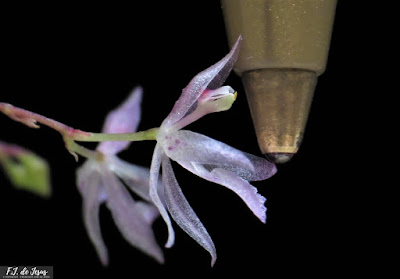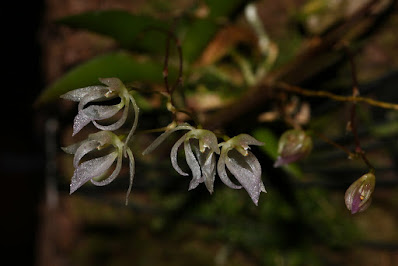Macroclinium chasei occurs in Bolivia, Peru and Brazil, in the Mato Grosso State. In Brazil, it was first found as an epiphyte...
Macroclinium chasei also called as Chase's Macroclinium, is a species of the genus Macroclinium. This species was described by Calaway Homer Dodson & David Edward Bennett in 1989.
IDENTIFY MACROCLINIUM CHASEI - CHASE'S MACROCLINIUM
Macroclinium chasei occurs in Bolivia, Peru and Brazil, in the Mato Grosso State. In Brazil, it was first found as an epiphyte of thin branches in the canopy in the paludose forest (Stational Forest Always Green Aluvial) crossed by a tributary stream of the Teles Pires river, in southern Amazonia. In Bolivia and Peru, it is found growing in tropical wet forests on old abandoned lichen and moss covered citrus trees at elevations around 200 to 850 meters.
It is a mini-miniature sized, hot growing epiphyte with stem compact, pseudobulbs absent and a fan of 3 to 4 alternate and imbricate, 0.7-1.4 x 0.4-0.5 cm, laterally compressed, falcate, slightly fleshy, apex acute to obtuse, green, with reticulate, brownish and thick ribs leaves.
Chase's Macroclinium blooms at most any time of the year on a basal to axillary, erect, slender, 2.5 cm long, successively several flowered inflorescence with several small, acute, cupped bracts and carrying 1 to 2 flowers open at a time. The flowers are white with purple-pink dots on the petals, the lip are white to white slightly pink, the column and anther are white with base purple-pink
MACROCLINIUM CHASEI - CHASE'S MACROCLINIUM CARE AND CULTURE
Cultural information should only be used as a guide, and should be to be adapted to suit you. Your physical location; where you grow your plants, how much time you have to devote to their care, and many other factors, will need to be taken into account. Only then can you decide on the cultural methods that best suit you and your plants.
Light:
Macroclinium chasei needs a light level of 12000-20000 lux. These plants need filtered or scattered light and protection from direct sunlight. Strong air movement should be ensured all the time.
Temperature:
The average summer temperature in the summer is 25 ° C, the average night is 15 ° C, which gives a daily amplitude of 10 ° C. The average winter temperature is 22-23 ° C during the day and 11-12 ° C at night, giving a diurnal difference of 9-12 ° C.
Humidity:
Chase's Macroclinium needs the humidity of 75-80% for most of the year, in winter for a month or more it drops to around 70%.
Substrate, growing media and repotting:
Macroclinium chasei grows best firmly attached to washers from pieces of tree fern. However, such plants require high humidity, and during hot and dry weather, they should be watered several times a day.
They can also be grown in small pots or baskets using a very airy, fast-drying substrate, which decomposes slowly. These plants are very sensitive to any manipulations, so you should overdo them as little as possible. A good substrate for these plants is cut wood fiber ferns with the addition of chopped sphagnum moss and pieces of pearlite, which provide the substrate with a loose structure, breathability and retain some moisture. The addition of charcoal also helps to keep the substrate cool and prevents it from getting sour.
The plants should be repotted immediately after noticing signs of substrate decomposition, or every few years when the plant grows out of the pot. If repotting is done at the time when new roots begin to appear, the plant will be accepted and rooted in the shortest possible time.
Watering:
The plants should be watered abundantly during periods of intensive growth, but excellent drainage should be ensured so that the ground around the roots is never spread or soggy. When new growths reach maturity in the autumn, the amount of water should be reduced.
Fertilizer:
During the active growth, the plants should be fertilized every week 1/4-1/2 of the recommended dose of fertilizer for orchids. You can use sustainable fertilizer throughout the year. You can also use high-nitrogen fertilizer from spring to mid-summer, passing in late summer and autumn to high phosphorus fertilizer.
Rest period:
Macroclinium chasei does not need rest period in winter to stimulate flowering. But it require less water in winter, and should not be dry for a longer period. Quite frequent morning fogging between rare, light watering should provide enough moisture, while allowing the necessary dry rest. Fertilization should be reduced or eliminated until new growths appear and a more abundant spring watering begins.















COMMENTS